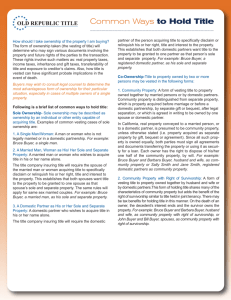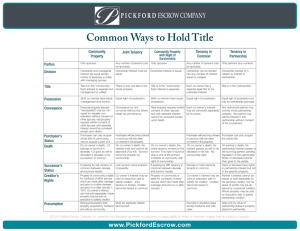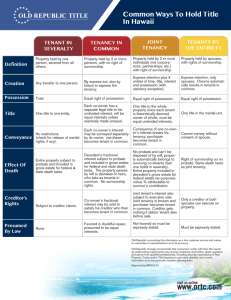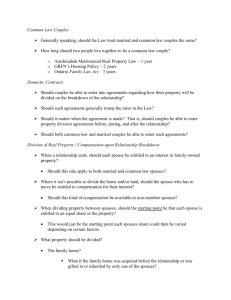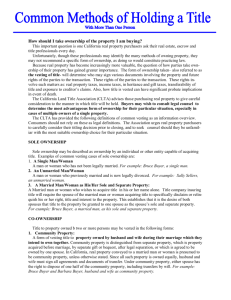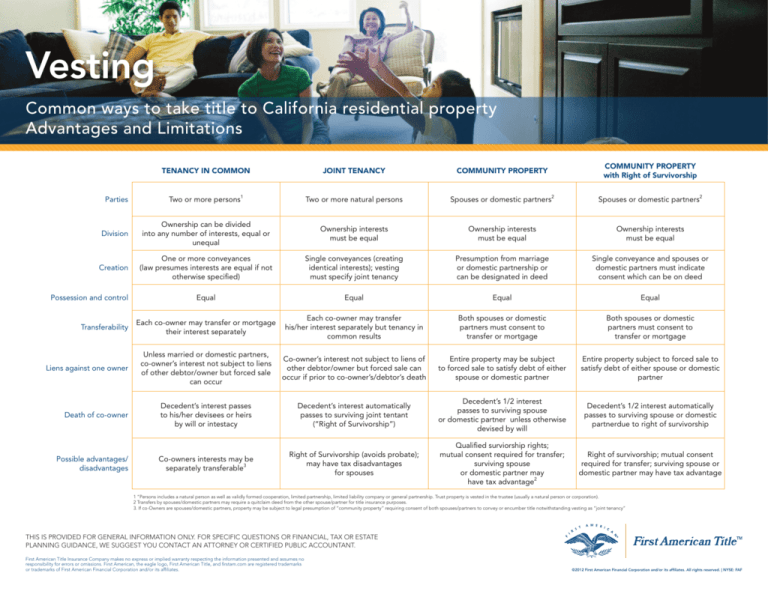
Vesting
Common ways to take title to California residential property
Advantages and Limitations
TENANCY IN COMMON
JOINT TENANCY
COMMUNITY PROPERTY
COMMUNITY PROPERTY
with Right of Survivorship
Parties
Two or more persons1
Two or more natural persons
Spouses or domestic partners2
Spouses or domestic partners2
Division
Ownership can be divided
into any number of interests, equal or
unequal
Ownership interests
must be equal
Ownership interests
must be equal
Ownership interests
must be equal
Creation
One or more conveyances
(law presumes interests are equal if not
otherwise specified)
Single conveyances (creating
identical interests); vesting
must specify joint tenancy
Presumption from marriage
or domestic partnership or
can be designated in deed
Single conveyance and spouses or
domestic partners must indicate
consent which can be on deed
Equal
Equal
Equal
Equal
Each co-owner may transfer or mortgage
their interest separately
Each co-owner may transfer
his/her interest separately but tenancy in
common results
Both spouses or domestic
partners must consent to
transfer or mortgage
Both spouses or domestic
partners must consent to
transfer or mortgage
Unless married or domestic partners,
co-owner’s interest not subject to liens
of other debtor/owner but forced sale
can occur
Co-owner’s interest not subject to liens of
other debtor/owner but forced sale can
occur if prior to co-owner’s/debtor’s death
Entire property may be subject
to forced sale to satisfy debt of either
spouse or domestic partner
Entire property subject to forced sale to
satisfy debt of either spouse or domestic
partner
Death of co-owner
Decedent’s interest passes
to his/her devisees or heirs
by will or intestacy
Decedent’s interest automatically
passes to surviving joint tentant
(“Right of Survivorship”)
Decedent’s 1/2 interest
passes to surviving spouse
or domestic partner unless otherwise
devised by will
Decedent’s 1/2 interest automatically
passes to surviving spouse or domestic
partnerdue to right of survivorship
Possible advantages/
disadvantages
Co-owners interests may be
separately transferable3
Right of Survivorship (avoids probate);
may have tax disadvantages
for spouses
Qualified surviorship rights;
mutual consent required for transfer;
surviving spouse
or domestic partner may
have tax advantage2
Right of survivorship; mutual consent
required for transfer; surviving spouse or
domestic partner may have tax advantage
Possession and control
Transferability
Liens against one owner
1 “Persons includes a natural person as well as validly formed cooperation, limited partnership, limited liability company or general partnership. Trust property is vested in the trustee (usually a natural person or corporation).
2 Transfers by spouses/domestic partners may require a quitclaim deed from the other spouse/partner for title insurance purposes.
3. If co-Owners are spouses/domestic partners, property may be subject to legal presumption of “community property” requiring consent of both spouses/partners to convey or encumber title notwithstanding vesting as “joint tenancy”
THIS IS PROVIDED FOR GENERAL INFORMATION ONLY. FOR SPECIFIC QUESTIONS OR FINANCIAL, TAX OR ESTATE
PLANNING GUIDANCE, WE SUGGEST YOU CONTACT AN ATTORNEY OR CERTIFIED PUBLIC ACCOUNTANT.
First American Title Insurance Company makes no express or implied warranty respecting the information presented and assumes no
responsibility for errors or omissions. First American, the eagle logo, First American Title, and firstam.com are registered trademarks
or trademarks of First American Financial Corporation and/or its affiliates.
©2012 First American Financial Corporation and/or its affiliates. All rights reserved. | NYSE: FAF
Vesting Descriptions
Title to real property in California may be held by
individuals, either in Sole Ownership or in Co-ownership.
Co-ownership of real property occurs when title is held
by two or more persons. There are several variations as
to how title may be held in each type of ownership. The
following brief summaries reference some of the most
common examples of each as providing by the California
Land Title Association.
Sole Ownership Sole ownership may be described as
ownership by an individual or other entity capable of acquiring
title. Examples of common vesting cases of sole ownership are:
1. A
Single Man or Woman, an Unmarried Man or
Woman or a Widow or Widower:
A man or woman who is not legally married or in a domestic
partnership. For example: Bruce Buyer, a single man.
2. A
Married Man or Woman as His or
Her Sole and Separate Property:
A married man or woman who wishes to acquire title in his or her
name alone.
The title company insuring title will require the spouse of the married
man or woman acquiring title to specifically disclaim or relinquish his
or her right, title and interest to the property. This establishes that
both spouses want title to the property to be granted to one spouse
as that spouse’s sole and separate property. The same rules will apply
for same sex married couples. For example: Bruce Buyer, a married
man, as his sole and separate property.
3. A
Domestic Partner as His or Her Sole and Separate
Property:
A domestic partner who wishes to acquire title in his or her name
alone.
The title company insuring title will require the domestic partner of
the person acquiring title to specifically disclaim or relinquish his or
her right, title and interest to the property. This establishes that both
domestic partners want title to the property to be granted to one
partner as that person’s sole and separate property. For example:
Bruce Buyer, a registered domestic partner, as his sole and separate
property.
CA - 07/2012
Co-Ownership
Title to property owned by two or more persons may be vested in the following forms:
1. Community
Property:
2. Community
Property with Right of Survivorship:
A form of vesting title to property owned together by married persons or by domestic partners. Community property is
distinguished from separate property, which is property acquired before marriage or before a domestic partnership by separate
gift or bequest, after legal separation, or which is agreed in writing to be owned by one spouse or domestic partner.
In California, real property conveyed to a married person, or to a domestic partner is presumed to be community property,
unless otherwise stated (i.e. property acquired as separate property by gift, bequest or agreement). Since all such property
is owned equally, both parties must sign all agreements and documents transferring the property or using it as security for
a loan. Each owner has the right to dispose of his/her one half of the community property by will. For example: Bruce Buyer
and Barbara Buyer, husband and wife, as community property, or Sally Smith and Jane Smith, registered domestic partners as
community property. Another example for same sex couples: Sally Smith and Jane Smith, spouses, as community property.
A form of vesting title to property owned together by spouses or by domestic partners. This form of holding title shares
many of the characteristics of community property but adds the benefit of the right of survivorship similar to title held in joint
tenancy. There may be tax benefits for holding title in this manner. On the death of an owner, the decedent’s interest ends and
the survivor owns all interests in the property. For example: Bruce Buyer and Barbara Buyer, husband and wife, as community
property with right of survivorship, or John Buyer and Bill Buyer, spouses, as community property with right of survivorship.
Another example for same sex couples: Sally Smith and Jane Smith, registered domestic partners, as community property with
right of survivorship.
3. Joint
Tenancy:
A form of vesting title to property owned by two or more persons, who may or may not be married or domestic partners, in
equal interests, subject to the right of survivorship in the surviving joint tenant(s). Title must have been acquired at the same
time, by the same conveyance, and the document must expressly declare the intention to create a joint tenancy estate. When
a joint tenant dies, title to the property is automatically conveyed by operation of law to the surviving joint tenant(s). Therefore,
joint tenancy property is not subject to disposition by will. For example: Bruce Buyer, a married man and George Buyer, a single
man, as joint tenants.
Note: If a married person enters into a joint tenancy that does not include their spouse, the title company insuring title may
require the spouse of the married man or woman acquiring title to specifically consent to the joint tenancy. The same rules will
apply for same sex married couples and domestic partners.
4. Tenancy
in Common:
A form of vesting title to property owned by any two or more individuals in undivided fractional interests. These fractional
interests may be unequal in quantity or duration and may arise at different times. Each tenant in common owns a share of the
property is entitled to a comparable portion of the income from the property and must bear an equivalent share of expenses.
Each co-tenant may sell, lease or will to his/her heir that share of the property belonging to him/her. For example: Bruce Buyer, a
single man, as to an undivided 3/4 interest and Penny Purchaser, a single woman, as to an undivided 1/4 interest.
Other ways of vesting title include:
1. Trustees
of a Trust:
A Trust is an arrangement whereby legal title to property is transferred by a grantor to a person called a trustee, to be held
and managed by that person for the benefit of the people specified in the trust agreement, called the beneficiaries. A trust is
generally not an entity that can hold title in its own name. Instead title is often vested in the trustee of the trust. For example:
Bruce Buyer trustee of the Buyer Family Trust.

